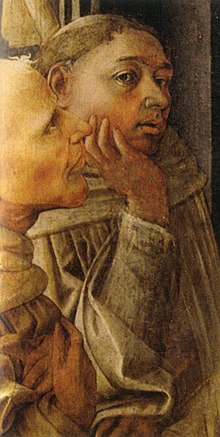Fra Filippo Lippi
| Fra' Filippo Lippi, O.Carm. | |
|---|---|

Selfportrait of Fra' Filippo Lippi
|
|
| Born |
Filippo Lippi ca. 1406 Florence, Republic of Florence |
| Died | 8 October 1469 (aged 62–63) Spoleto, Papal States |
| Nationality | Italian |
| Known for | Painting, Fresco |
| Notable work | Madonna and Child Enthroned, Annunciation |
| Movement | Early Renaissance |
Fra' Filippo Lippi, O.Carm. (c. 1406 – 8 October 1469), also called Lippo Lippi, was an Italian painter of the Quattrocento (15th century).
Lippi was born in Florence around 1406 to Tommaso, a butcher, and his wife. Both his parents died when he was still a child. Mona Lapaccia, his aunt, being too poor to rear him, placed him at the age of eight in the neighbouring Carmelite convent, where he was educated. In 1420 he was admitted to the community of Carmelite friars of the Priory of Our Lady of Mount Carmel in Florence, taking religious vows in the Order the following year, at the age of sixteen. He would have been ordained a priest sometime around 1425, and remained in residence in that priory until 1432. Vasari writes that Lippi was inspired to become a painter by watching Masaccio at work in the Carmine church, and his early work, notably the Tarquinia Madonna (Galleria Nazionale, Rome) shows that influence. In his Lives of the Artists, Vasari says: "Instead of studying, he spent all his time scrawling pictures on his own books and those of others." The prior decided to give him the opportunity to learn painting.
Eventually Fra Filippo quit the monastery, but it appears he was not released from his vows; in a letter dated 1439 he describes himself as the poorest friar of Florence, charged with the maintenance of six marriageable nieces. The altarpiece Lippi painted in 1441 for the nuns of S. Ambrogio is now a prominent attraction in the Academy of Florence, and was celebrated in Browning's well-known poem Fra Lippo Lippi. It represents the coronation of the Virgin among angels and saints, including many Bernardine monks. One of these, placed to the right, is a half-length figure originally thought to be a self-portrait of Lippo, pointed out by the inscription is perfecit opus upon an angel's scroll; it was later divulged to be a portrait of the benefactor who commissioned the painting.
...
Wikipedia
